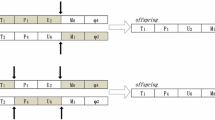Abstract
Multi-UAV cooperative reconnaissance is one of the most challenging research area for UAV operations. The objective is to coordinate different kinds of sensor-bearing UAVs conducting reconnaissance on a set of targets within predefined time windows at minimum cost, while satisfying the reconnaissance demands, and without violating the maximum permitted travel time for each UAV. This paper presents a multi-objective optimization mathematical formulation for the problem. Different from previous formulations, the model takes the reconnaissance resolution demands of the targets and time window constraints into account. Then a multi-objective genetic algorithm CR-MOGA is put forward to solve the problem. In CR-MOGA, Pareto optimality based selection is introduced to generate the parent individuals. Novel evolutionary operators are designed according to the specifics of the problem. Finally the simulation results show the efficiency of our algorithm.
Preview
Unable to display preview. Download preview PDF.
Similar content being viewed by others
References
Ryan, J.L., Bailey, T.G., Moore, J.T., Carlton, W.B.: Reactive Tabu Search in Unmanned Aerial Reconnaissance Simulations. In: Winter Simulation Conference, Washington D.C, pp. 873–879 (1998)
Hutchison, M.G.: A Method for Estimating Range Requirements of Tactical Reconnaissance UAVs. In: AIAA’s 1st Technical Conference and Workshop on Unmanned Aerospace Vehicles, Virginia, pp. 120–124 (2002)
Ousingsawat, J., Campbell, M.E.: Establishing Trajectories for Multi-Vehicle Reconnaissance. In: AIAA Guidance, Navigation, and Control Conference and Exhibit, Providence, Rhode Island, pp. 1–12 (2004)
Van Veldhuizen, D.A., Lamont, G.B.: Multiobjective Evolutionary Algorithms: Analyzing the State-of-the-Art. Evolutionary Computation 8(2), 125–147 (2000)
Zitzler, E., Laumanns, M., Bleuler, S.: A Tutorial on Evolutionary Multiobjective Optimization. Metaheuristics for Multiobjective Optimisation 535, 3–37 (2004)
Solomon, M.M.: Algorithms for Vehicle Routing and Scheduling Problems with Time Window Constraints. Operations Research 35(2), 254–265 (1987)
Author information
Authors and Affiliations
Editor information
Editors and Affiliations
Rights and permissions
Copyright information
© 2006 Springer-Verlag Berlin Heidelberg
About this paper
Cite this paper
Tian, J., Shen, L., Zheng, Y. (2006). Formulation and a MOGA Based Approach for Multi-UAV Cooperative Reconnaissance. In: Luo, Y. (eds) Cooperative Design, Visualization, and Engineering. CDVE 2006. Lecture Notes in Computer Science, vol 4101. Springer, Berlin, Heidelberg. https://doi.org/10.1007/11863649_13
Download citation
DOI: https://doi.org/10.1007/11863649_13
Publisher Name: Springer, Berlin, Heidelberg
Print ISBN: 978-3-540-44494-7
Online ISBN: 978-3-540-44496-1
eBook Packages: Computer ScienceComputer Science (R0)




